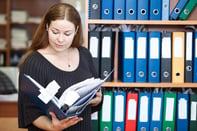Published on
Higher Education in a Pre-Pandemic Society (Part 1)

Innovation in higher education is not new-–it just takes a while to catch on. We are really good at letting others test the waters and occasionally checking it ourselves to see if the temperature is right and it is time to jump in. There was no choice these last few weeks; all of education had to leap immediately into distance learning to keep courses afloat. Although the future is still unknown, and we feel a bit at sea, understanding where we came from and the innovations that were underway can help us clarify where we are and where we can go.
The first two decades of the 21st century brought enormous changes to higher education. Faced with an economic downturn brought on by lower numbers in the 18- to 24-year old student population– after decades of expansion based on numbers from previous generations–colleges and universities began to re-think their approaches to different student populations, including adult learners. Given the rapid developments in technology, industries were redesigning themselves and needed a different type of educated workforce: one that could apply a liberal arts education into field specifics, while integrating technology and contributing to industry advances. Technologies permeated all job levels to the point that most positions now need some form of postsecondary education to work in advanced technology areas. In response, higher education launched a redesign to include a greater focus on:
- Equity, inclusion, and access to address the large numbers of students from underrepresented ethnic, socio-economic and age groups, who needed further education. Preparing individuals for the workforce, especially targeting areas such as advanced manufacturing, computer coding, heath care, and other high-demand fields. Industry and educational institutions increased their partnerships to address curricular gaps and provide better alignments. New programs emerged, especially at the community college level.
- Online learning to better fit education into the lives of students, especially adults; decrease costs of brick-and-mortar classrooms while also increasing enrollment; and take advantage of open educational resources and various technologies that could enhance educational experiences. New forms of online learning emerged, such as MOOCs, open educational resources and free or reduced cost alternative delivery models.
- Transfer models (e.g., 2+2) and articulation agreements to enable students to move more effectively from community colleges to four-year institutions and across institutions. Data showed that transferring schools was a barrier to degree progression and completion. Many students were forced to repeat courses or start their degree over when changing institutions, increasing costs and often preventing students from achieving the credentials needed to advance in employment.
- Learning recognition, such as prior learning assessment, to assess better understand what people know and can do, regardless of the learning source. With an increase in adult learner populations, institutions were faced with a population who had prior knowledge from work and life experiences and were frustrated at having to take courses in areas in which they already had equivalent college-level learning. Originally, a practice that emerged at only a few adult-friendly institutions from a social justice and equity perspective, prior learning assessment research (e.g., Klein-Collins[i]) indicated that students who received prior learning credits were more likely to persist and complete their education when compared to their non-prior- learning counterparts, and soon other institutions initiated prior learning assessment practices to address declining enrollments.
- Authentic and direct assessments of learning, rather than measuring seat-time through the credit-hour, to signal better what someone knows and can do. Competency-based education emerged, and efforts began to better identify and connect competencies acquired through work and school to prepare individuals for further employment. Learning assessments evolved to capture the depth and breadth of learning and identify acquired competencies. Competencies, as a universal language,[ii] were seen as a way to translate, describe, and bridge learning across all its sources: work, life, and school,; and, considered timeless, it could be recognized, validated, credentialed, and transferred across academic programs, jobs, and fields.
- Alternative credentialing to provide incremental recognition of competencies. New forms of credentialing, such as badges, micro-credentials and micro-degrees appeared, as well as new forms of delivery for concentrated field-specific areas, such as bootcamps and industry-specific “universities” (e.g., McDonald’s Hamburger University). The comprehensive student record emerged to capture and be more transparent of competencies students acquire through various learning opportunities while attending the higher education institutions. New initiatives, such as Credentials Engine, were created to provide consumers with information and make transparent the complex myriad of credentials that evolved to capture learning outside the traditional degree structure.
Despite these enormous efforts, carried out piecemeal across the nation, higher education still was not credentialing enough people to fill the ever-increasing job market demand. The Center on Education and the Workforce estimated there would be 55 million job openings by 2020, of which 65 percent required an associate’s or bachelor’s degree, or at least some college education.[iii] Of the 184 million working-aged adults (20 – 74 years old) in this country,[iv] 55.5% have less than a high school degree, a high school degree, or some college experience but no completed postsecondary degree.[v] The National Student Clearinghouse determined that there are 36 million Americans who fall in the latter category of having some college but no postsecondary degree,[vi] while the Lumina Foundation estimated that an additional 3.2 million people hold industrial certifications that are not transferable into post-secondary institutions. [vii] These shortages put the nation at risk of not having a sufficient workforce to meet industry needs.
This is also a huge equity issue. Job attainment has clear discrepancies across race and ethnicity.[viii] When people are not recognized for what they know and can do, they cannot get work. The ways in which people are recognized, assessed, and credentialed for their knowledge and skills shapes who is accepted into and can complete post-secondary education. When someone has knowledge that is goes not unrecognized or is instead sealed within a credential, they are treated as though they have no knowledge; unfinished education and prior learning doesn’t count. This system has held back the higher education completion agenda and hindered addressing the severe shortage of a credentialed workforce in the United States.
Despite previous efforts to move higher education into the 21st century, the basic educational structure has been closer to the industrial age when people needed the same skills gained through a similar education. In fact, people born before 1960 are closer to the 1800’s than 2020,[ix] which brings up a pedagogy of uniformities: everyone has the same assignments, the same assessments, and the same curriculum. The current educational system is hinged on a philosophy that assessing and credentialing knowledge at an individual level is not valid; yet, innovative methods indicate otherwise, and this philosophy cuts away more than half the adult population from being seen for what they do know and can do.
References
[i] Klein-Collins, R. (2010). Fueling the Race to Postsecondary Success: A 48-institution Study of Prior Learning Assessment and Adult Student Outcomes. Chicago: Council for Adult and Experiential Learning. https://www.cael.org/pla/publication/fueling-the-race-to-postsecondary-success.
[ii] Connecting Credentials. Connecting Credentials Action Plan. http://connectingcredentials.org/action-plan-4-pager/.
[iii] Carnevale, A., Smith, N., & Strohl, J. (2013). Recovery: Projections of Jobs and Education Requirements Through 2020. Center on Education and the Workforce, Georgetown University https://cew.georgetown.edu/cew-reports/recovery-job-growth-and-education-requirements-through-2020.
[iv] Infoplease.com. https://www.infoplease.com/us/comprehensive-census-data-state/demographic-statistics-342.
[v] American Council on Education. United States Population Trends and Educational Attainment. https://www.equityinhighered.org/indicators/u-s-population-trends-and-educational-attainment/educational-attainment-by-race-and-ethnicity/.
[vi] National Student Clearinghouse Research Center (2019). Some College, No Degree: A Snapshot for the Nation and 50 States. https://nscresearchcenter.org/some-college-no-degree-2019/
[vii] Lumina Foundation, Lumina’s Goal https://www.luminafoundation.org/lumina-goal
[viii] Carnevale, A., Strohl, J., Gulish, A., Van Der Werf, M., Campbell, K. P. (2019). The Unequal Race for Good Jobs: How Whites Made Outsized Gains in Education and Good Jobs Compared to Blacks and Latinos. Center on Education and the Workforce, Georgetown University https://cew.georgetown.edu/cew-reports/raceandgoodjobs/
[ix] Urban T. It’s 2020 and You’re in the Future. 2020. https://waitbutwhy.com/2020/01/its-2020-and-youre-in-the-future.html.
Author Perspective: Administrator



